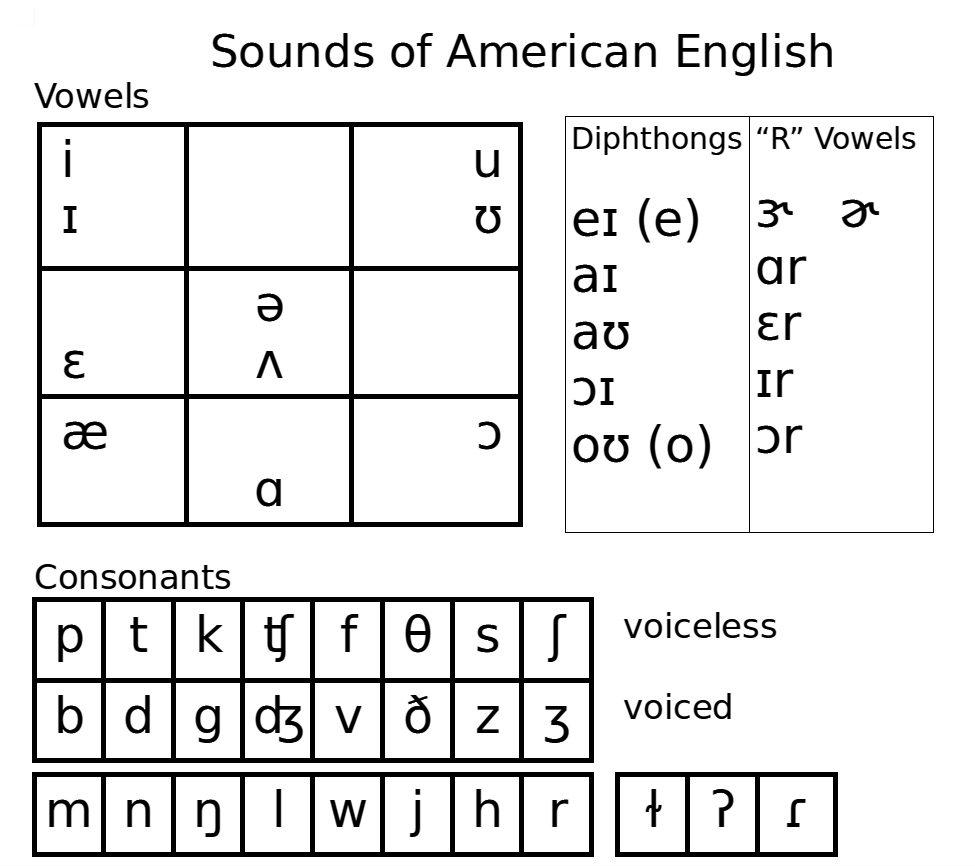Imitation
Try to mimic the pronunciation in the following video.
Review

Listen to the difference between voiced and voiceless consonants:
- ɑt ɑd
- ip ib
- oʊk oʊg
- _t _d
- _p _b
- _k _g
What are the stress rules?
What if you have two nouns together? Which one is stressed?
What if you have a two-word verb? Which one is stressed?
When do you break the stress rules?
Homework
Here is the dialog with the words marked according to the stressed rules:
ˈGood ˈmorning, ˈSusan. ˈWhere are you ˈgoing?
ˈHi, ˈMrs. ˈJones! I’m ˈgoing to the ˈstore.
I ˈneed to ˈgo, ˈtoo. ˈLet’s ˈgo toˈgether.
ˈSounds ˈgood. Are you ˈbuying ˈfood?
ˈYes. I ˈwant to ˈget ˈsomething ˈhealthy for my ˈfamily.
Will you ˈget ˈfruit or ˈvegetables?
ˈYes, but there’s a ˈproblem.
My ˈkids ˈdon’t ˈlike ˈvegetables, and my ˈhusband ˈdoesn’t ˈlike ˈfruit.
So will you ˈget ˈfruit or ˈvegetables?
I ˈthink I’ll ˈget ˈboth: ˈapples, baˈnanas, ˈcarrots, and toˈmatoes.
You ˈhave ˈtwo ˈkids, ˈdon’t you?
ˈYes. ˈTwo ˈboys.
Iˈm ˈsure they ˈeat a ˈlot, ˈdon’t they?
ˈThat’s for ˈsure. They ˈeat ˈmore than my ˈhusband does.
ˈHow ˈoften do you ˈhave to ˈgo ˈshopping?
About ˈtwice a ˈweek.
Do you ˈusually ˈwalk to the ˈstore?
ˈNo, I ˈusually ˈdrive to the ˈstore.
ˈWell, ˈhere we are.
Here it is again with the stress marks adjusted for better rhythm and meaning:
ˈGood ˈmorning, ˈSusan. ˈWhere are you ˈgoing?
ˈHi, ˈMrs. ˈJones! I’m ˈgoing to the ˈstore.
ˈI need to go, ˈtoo. Let’s ˈgo toˈgether.
ˈSounds ˈgood. Are you ˈbuying ˈfood?
ˈYes. I ˈwant to get something ˈhealthy for my ˈfamily.
Will you get ˈfruit or ˈvegetables?
ˈYes, but there’s a ˈproblem.
My ˈkids don’t like ˈvegetables, and my ˈhusband doesn’t like ˈfruit.
So will you get ˈfruit or ˈvegetables?
I ˈthink I’ll get ˈboth: ˈapples, baˈnanas, ˈcarrots, and toˈmatoes.
You have ˈtwo kids, ˈdon’t you?
ˈYes. ˈTwo ˈboys.
Iˈm ˈsure they ˈeat a ˈlot, ˈdon’t they?
ˈThat’s for sure. ˈThey eat ˈmore than my ˈhusband does.
How ˈoften do you ˈhave to go ˈshopping?
About ˈtwice a ˈweek.
Do you ˈusually ˈwalk to the ˈstore?
ˈNo, I ˈusually ˈdrive to the ˈstore.
ˈWell, ˈhere we ˈare.
Word blending
As you have seen with contractions in the previous lesson, blending words together is common in English. Even in words that don’t get contracted, there are many instances where the end of one word will join the start of the next word.
Word blending happens in the following situations:
- Consonant + Vowel: One word ends with a consonant and the next word starts with a vowel
- Vowel + Vowel: One word ends with a vowel and the next word also starts with a vowel
- Plosive consonant + Consonant: One word ends with a plosive consonant (p, b, t, d, k, g) and the next word starts with a consonant
- Same sounds: One word ends with the same sound that the next one begins with
You’ll see examples of these below:
Consonant + Vowel
The consonant and the vowel join together. Listen to the following examples:
- an apple
- come in
- speak English
- put on
- take out
- pick up
- all of us
- take it away
- keep it up
Note that the blending is according to sound, not spelling. “Come” ends with the consonant sound /m/ because the “e” is silent.
/j/ and /w/ are semi-vowels so if they begin the second word you can also treat them like vowels:
- have you
- splash yellow
- he’s won
- then when
Vowel + Vowel
The two vowels join together. Don’t stop the air flowing or your voice sounding between them.
- go out
- my only
- how old
- see off
- may I
- who else
- the apple
Since /j/ and /w/ are semi-vowels, you can also blend them when they start the second word. (The sounds /j/ and /w/ never come at the end of a word in English.)
- who yelled
- go yonder
- see Wendy
- she won’t
Plosive Consonant + Consonant
When you have /p/, /b/, /t/, /d/, /k/, or /g/ followed by another consonant, don’t let out a breath of air after the plosive consonant. Instead, blend it into the next consonant.
- hit them
- deep down
- great deal
- silk purse
- dig down
- red shirt
- stop John
- fast train
- Bob Jones
Same sounds
When one word ends with the same sound that the next one begins with, these are naturally blended. Rather than pronouncing the sound twice, you just say it once.
- wish she
- half frozen
- won nothing
- real letter
- Tom makes
- with those
Student teacher examples
Here are some students reading some words that should be blended together.
There is a pair of glasses on the desk.
my only son
all of us
put it on
take it away
in August
best of all
more over
far away
go out
too often
look at it
pick it up
forever
any other
go on
see off
how old
lamp glass
pocket book
great deal
silk purse
cardboard
red card
button*
certain*
what next
park gate
a red shirt
a black jacket
a fast train
at night
These phrases come from the book 英语语音语调 by Zhang Guanlin and Sun Jingyuan.
* These words are not really word blending since they are only single words, but notice the glottal stop.
Jokes
There is a genre of jokes where the author has a funny name based on the title of the book. Many of these have word blending as a part of the joke. Here are some examples:
- Bad Falls by Eileen Dover
- A Stuntman To The End by Kenny Doitt
- Almost Missed the Bus by Justin Time
- Chest Pain by I. Coffalot
- Don’t Tread On Me by Amanda B. Reckonwith
- How to Succeed in School by Rita Book
- I Hate the Sun by Gladys Knight
How to show word blending
You can show word blending by using an ‿ undertie character between the words that are blended.
- an‿apple
- go‿out
- hit‿them
Practice
Find the likely places for word blending in the dialog:
Good morning, Susan. Where are you going?
Hi, Mrs. Jones! I’m going to the store.
I need to go, too. Let’s go together.
Sounds good. Are you buying food?
Yes. I want to get something healthy for my family.
Will you get fruit or vegetables?
Yes, but there’s a problem.
My kids don’t like vegetables, and my husband doesn’t like fruit.
So will you get fruit or vegetables?
I think I’ll get both: apples, bananas, carrots, and tomatoes.
You have two kids, don’t you?
Yes. Two boys.
I’m sure they eat a lot, don’t they?
That’s for sure. They eat more than my husband does.
How often do you have to go shopping?
About twice a week.
Do you usually walk to the store?
No, I usually drive to the store.
Well, here we are.
More practice
- Listen to the imitation video at the start of this lesson again. Where is there word blending?
- Find a written passage. Mark the locations where word blending is likely.
Homework
Find 10 examples of word blending with real audio from a native speaker. You can use YouTube or another source.

Hi, enjoy reading and listening to your exercises. By the way, thank you for these word blending notes that is very helpful in my class.